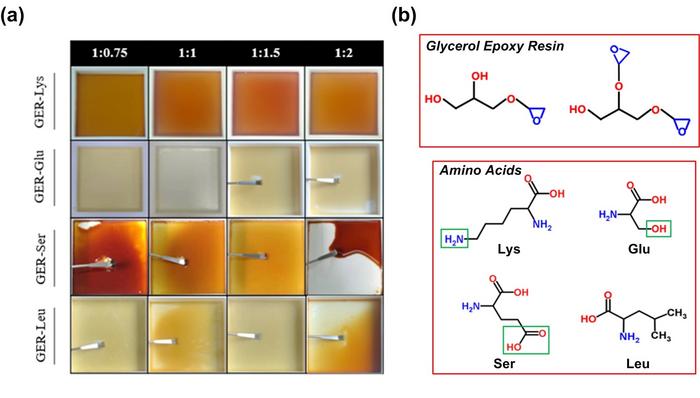Epoxide exhibits superior crosslinking properties, thereby enhancing the bonding performance of soy protein adhesives owing to its elevated glass transition temperature and mechanical property. Commercia resins are mainly derived from petroleum and contain the toxic chemical bisphenol A. Although commercial hardeners have been extensively utilized, these systems still have particular environmental concerns that have been become particularly notable in recent years. Amino acids, a bio-based epoxy curing agent with amino and carboxyl groups, are another potential curing agent. Water-soluble epoxy resins cured with lysine (Lys), glutamic acid (Glu), leucine (Leu), and serine (Ser) as amino acids were investigated. The results showed that the water-soluble epoxy resin (glycerol epoxy resins, GER) was cured with Lys and Glu after reacting. The potential of Lys and Glu alternatives for petrochemical amines is demonstrated and provides promising opportunities for industrial application.

Credit: Changlei Xia, College of Materials Science and Engineering, Nanjing Forestry University, Nanjing 210037, China, [email protected]
Epoxide exhibits superior crosslinking properties, thereby enhancing the bonding performance of soy protein adhesives owing to its elevated glass transition temperature and mechanical property. Commercia resins are mainly derived from petroleum and contain the toxic chemical bisphenol A. Although commercial hardeners have been extensively utilized, these systems still have particular environmental concerns that have been become particularly notable in recent years. Amino acids, a bio-based epoxy curing agent with amino and carboxyl groups, are another potential curing agent. Water-soluble epoxy resins cured with lysine (Lys), glutamic acid (Glu), leucine (Leu), and serine (Ser) as amino acids were investigated. The results showed that the water-soluble epoxy resin (glycerol epoxy resins, GER) was cured with Lys and Glu after reacting. The potential of Lys and Glu alternatives for petrochemical amines is demonstrated and provides promising opportunities for industrial application.
DOI
https://doi.org/10.1016/j.jobab.2024.01.003
Original Source URL
https://www.sciencedirect.com/science/article/pii/S2369969824000148
Journal
Journal of Bioresources and Bioproducts
Journal
Journal of Bioresources and Bioproducts
DOI
10.1016/j.jobab.2024.01.003
Method of Research
Experimental study
Article Title
Nucleophilic amino acids as a renewable alternative to petrochemically-derived amines in glycerol epoxy resins
Article Publication Date
23-Jan-2024
COI Statement
The authors have no financial or personal competing interests to declare which could have influenced this manuscript.




